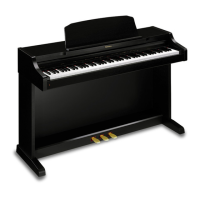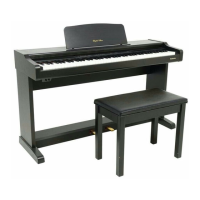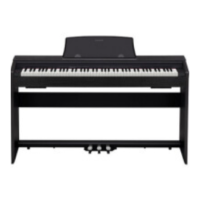
Do you have a question about the Technics SX-PX552 and is the answer not in the manual?
| Type | Digital Piano |
|---|---|
| Number of Keys | 88 |
| Keyboard | Weighted Hammer Action |
| Touch Sensitivity | Yes |
| Polyphony | 64 notes |
| Sound Source | PCM |
| Effects | Reverb, Chorus |
| Headphone Jacks | 2 |
| MIDI | Yes |
| USB | No |
| Built-in Speakers | Yes |
| Tones | Strings |
Information regarding electrical hazards and the need for qualified service personnel.
Details on the equipment's compliance with FCC rules for digital devices and interference mitigation.
Basic precautions for using electric products, including power source, polarization, and non-use.
Advice on safe listening levels to prevent hearing loss.
Guidelines for product servicing by qualified personnel and routine maintenance.
Steps to plug in the power, turn on the unit, and set the main volume.
Instructions for opening/closing the keyboard cover and setting up the music stand.
Note on digital piano tuning and pitch adjustment for ensemble playing.
How to play the grand piano demonstration tunes using the DEMO button and SOUND buttons.
Instructions on how to stop the demonstration performance by pressing the DEMO button.
Steps to select and listen to demonstration tunes for various sounds.
How to play all demonstration tunes in order and loop them.
How to select sounds, mix two sounds, and use organ presets.
Explanation of the DIGITAL REVERB and DIGITAL EFFECT features for sound enhancement.
Description of the Sostenuto pedal and Soft pedal functions.
How to adjust the sound brightness using the BRIGHT and MELLOW buttons.
Options for adjusting keyboard touch response (LIGHT, NORMAL, HEAVY).
Information on the display's function and an introduction to the sequencer.
Explanation of the sustain pedal's effect on note duration.
Steps to activate and hear organ sounds using the ORGAN PRESETS button.
How to select specific organ sounds using TEMPO buttons and DIGITAL EFFECT.
Instructions on how to play and mix two different sounds simultaneously.
How to adjust the volume balance between two mixed sounds using TEMPO buttons.
How to use the TRANSPOSE buttons to change the key of the instrument.
Procedure for adjusting the instrument's pitch for ensemble playing.
How to select DIGITAL REVERB types and adjust their depth.
Explanation of string resonance and how to adjust its amount.
How to turn on the metronome, adjust tempo, and stop it.
How to adjust the metronome's volume level.
How to select time signatures and add accents to the metronome beat.
Introduction to storing and playing back performances using the SEQUENCER.
Instructions for recording performance data, including multi-track recording.
Step-by-step guide to recording the first track of a performance.
Step-by-step guide to recording the second track, synchronized with Track 1.
Further information on sequencer recording capacity, errors, and simultaneous recording limits.
How to play back recorded tracks and erase them.
Details on PIANO TUNING and MINIMUM RANGE settings.
How to set functions by pressing MODE SET and other buttons.
Procedure to reset all settings to default status.
Description of MIDI OUT and MIDI IN terminals for data exchange.
List of data types that can be transmitted/received via MIDI.
How to assign a MIDI CHANNEL number (1-16) to the instrument.
Settings for MULTI TIMBRE and OMNI ON for MIDI operation.
MIDI functions related to PROGRAM CHANGE, Pedal, and Effect data.
MIDI functions for TRANSPOSE and LOCAL CONTROL settings.
Procedure to set MIDI functions using MODE SET and panel buttons.
Illustration showing keyboard layout and corresponding MIDI note numbers.
Table showing how to specify BANK and NUMBER for PROGRAM CHANGE.
How sound buttons map to PROGRAM CHANGE numbers for PX552 and PX554.
Description of PEDAL IN, AUX IN, LINE OUT, and HEADPHONES connections.
How to connect the piano to computers (Macintosh and PC).
Lists common operational issues and their solutions.
Details on memory retention after power off and initialization.
Identifying parts and attaching side planks to the pedal box.
Steps for affixing the rear panel and placing the piano body on the stand.
Connecting pedal/power cords and performing final assembly checks.
Details on functions, modes, and data types transmitted/recognized by MIDI.
Explanation of different MIDI modes (Omni On/Off, Poly/Mono).
Detailed specifications for keyboard, polyphony, sounds, effects, and more.
Information on power requirements, physical dimensions, net weight, and accessories.
List of demo songs, their composers, and corresponding sound names.











